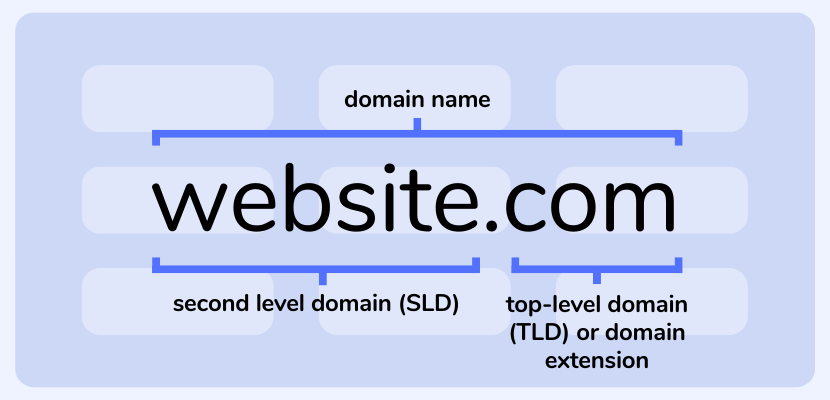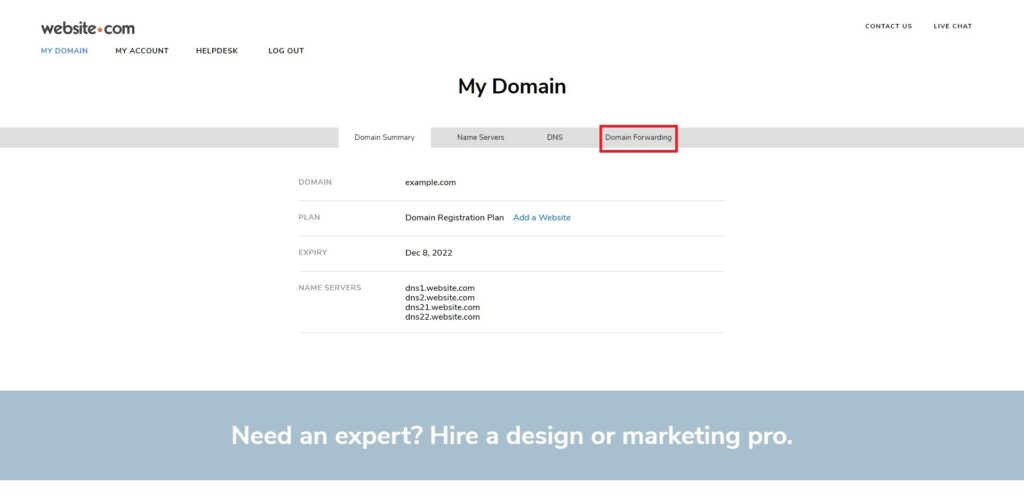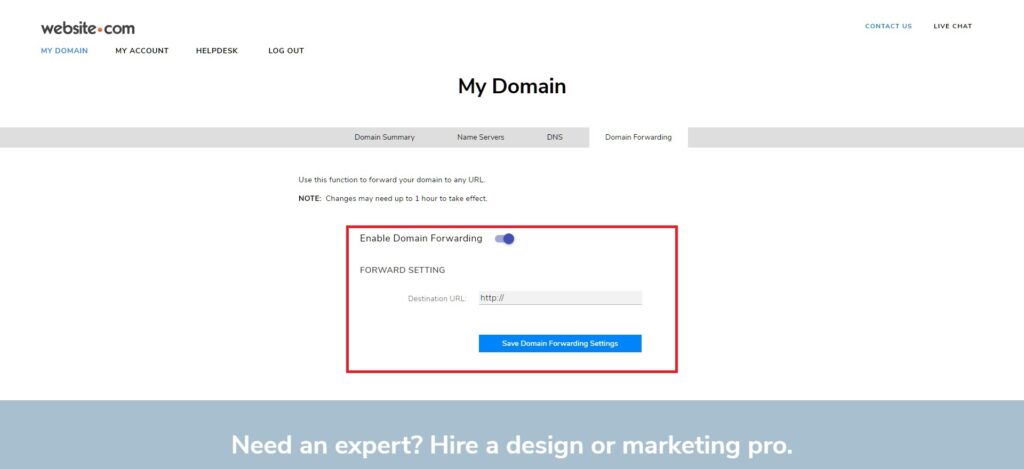Every website address consists of the domain name, which is the part after the www., and the domain extension, the part coming after your domain name that is usually something like .com, .org, .net, and many others. Even one small variation in a website address can make two very similar names connect to entirely different websites, which is why it’s important for you as a website owner to register as many relevant domain names as you can.

A domain name is the name used to identify different websites from one another. An example of a domain name is “website.com”. Typically, you’ll enter or use domain names to find websites or content that you’re looking for. From here, the parts of a domain name can be split into two parts: the part of it that’s the second level domain (SLD), and the part of it that’s the top-level domain (TLD).
Second level domains (SLDs) are what your website visitors will associate with your website most frequently. In the domain name website.com, for example, it’s the “website” part of the domain name. This part of your domain name is what stands out to website visitors the most, making it a key part of your domain name and your overall online presence. It’s an online name representing your online presence, so it’s important to decide on a good second level domain for your website.
Top-level domains (TLDs) are the part that comes after your second level domain. In the domain name website.com, for example, it’s the “.com” part of the domain name. There are a variety of top-level domains you can use, such as .com, .net, and more. There are also location-specific TLDs, called country code top-level domains, or ccTLDs, such as .us, .ca, .uk, and more. We’ll discuss more about country code top-level domains soon.
Alongside protecting your website’s security and reputation online, what you can do with these domain names after you’ve registered with them is to forward their domains to your original mainly-used website. With domain forwarding, you can redirect your visitors to any other website of your choosing. Use this feature to make sure any website addresses that you own are sending people to the right places. In this article, learn how you can protect your website addresses by registering multiple domain names, and how you can set up domain forwarding to put different website addresses to their best use.
Why You Should Register Multiple Domain Names
Registering different domain names that are similar but slightly different from yours is an important part of having a business website and maintaining your online presence. Even if another domain name is only one letter off from your domain name, or it has the same second level domain (SLD) but a different top-level domain (TLD), it becomes a different domain name that someone else could register and use for their own. There are several reasons why you would want to register multiple domain names for your website:
1. Prevent Problems from Typos or Spelling Guesses
Everyone makes typos sometimes, and this could happen when a potential visitor to your site is typing in your domain name to visit your website. Especially if your domain name contains any unique or lesser-used words, people might make typos or simply not be sure how to spell it. This is why it’s a good idea to register domain names that cover for typos or guesses at how to spell your website name, so that people can still find your website regardless of any mistakes or guesses they might make. Additionally, different regions may have different ways of spelling words, such as the word “center” being spelled this way in the US, while being spelled “centre” elsewhere in countries like the UK or Canada. If your business or website name includes these words, it’s smart to register domain names that use all relevant spellings, so your visitors can always find your site regardless of how words are spelled where they are.
2. Stop Impersonation Look- and Sound-Alikes
Others might be tempted to register names that look and sound very similar to your domain name, but for their own purposes, such as impersonating you and tricking your potential visitors into visiting their website instead. You can prevent this by registering these sorts of names for yourself to prevent these attempted impersonators of your domain name.
3. Protect your Online Reputation
Sometimes, other people registering a similar domain name to your website can go further than simply impersonating you to trick potential visitors into visiting their site instead. They may intend to use their similarly-named site for unprofessional or inappropriate purposes, or for forwarding visitors to websites that feature this sort of content, which are uses that you would have no control over them implementing. Tricked visitors may, as a result, confuse this content for your content, which would damage your reputation, with no easy solution to this. Keep your reputation safe by registering different domain names and keeping your business’s name safe.
4. Be Location-Specific for Visitors
If your website is location-specific, or has different versions across different locations or countries, you should consider registering region-specific domain extension versions of your website address to make sure your site’s content can be as relevant to your visitors as possible. These are country code top-level domains, or ccTLDs, such as .us, .ca, .uk, and more. Depending on where you and your business/website are based, people might assume your website ends with a different top-level domain. This is why it’s important to register any country or region-specific top-level domains that would be relevant to your website and business. With this, you can make different versions of your website depending on which country code top-level domain is used for it, so that different customers located in different countries or regions can access information more specific and relevant to where they are.
Once you have domain names registered, you can put them to use by using domain forwarding. Domain forwarding means that anyone who reaches the address you’ve set up domain forwarding on will instead be forwarded to another website address that you’ve specified to be their new destination.
For example, let’s say your main website is named websitename.com. You’ve just successfully registered the domain name websitename.net, and want to make sure anyone who tries to reach your site will be able to reach it, regardless of if they enter the .com or .net website addresses. To resolve this problem, you can set up domain forwarding on websitename.net to send any visitors to that site immediately to websitename.com instead. This ensures you can make full use of any domain names you register, because you won’t be losing any visitors and will instead be ensuring all visitors are able to find your website for the purposes they want to.
As another option, you can use domain forwarding to send visitors to a specific website address you own to your social media profiles instead. For example, imagine if you were a self-employed house painter who’s been getting customers and site visitors through a Facebook group. You want to promote your service with a catchy and easy-to-remember domain name, but still want to keep using your Facebook group as your main platform for your business. In this scenario, you’d benefit from directing visitors of the domain name to your Facebook group using domain forwarding to maximize your reach and success with interesting customers.
How to Set Up Domain Forwarding
Now that you’re aware of the value that domain forwarding can offer you, you can set up domain forwarding for yourself in just a few simple steps.
First, you can register a new domain name. Head to https://www.website.com/domain-name-search/
After choosing your domain name and clicking Get It Now, click “Choose 1-Year Domain Registration.”
Create a new login for your new domain name (each new domain name will need its own login credentials). Proceed to make your payment.
Now you will need to wait for an email from Website.com to confirm that your domain has been registered. Once it has been registered, you can set up domain forwarding!
To set up domain forwarding, you will need to log into your newly created account.
Head to the Website.com website and log into your newly created account. Once you’ve logged in, click the “Domain Forwarding” tab in the top menu bar of the page.

On the new page you arrive on, toggle on the “Enable Domain Forwarding” option.

Once you have domain forwarding toggled on, you can enter your destination website address.

Once you’ve entered your destination address, press the “Save Domain Forwarding Settings” button. This confirms your decision to use your current website address for domain forwarding. Remember that it might take up to 1 hour for the domain forwarding to take effect.
Now you know why and how you should register multiple domain names and use domain forwarding. Remember these tips to put your multiple domain names to their best uses, and to maximize your online presence’s chances of success.
